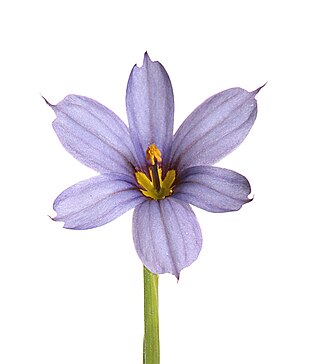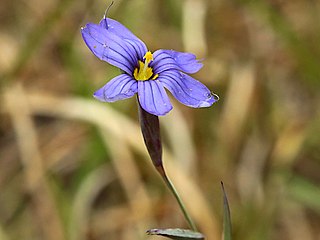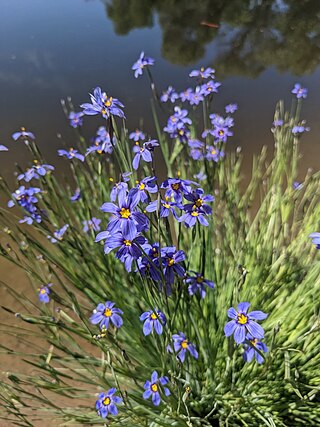
Sisyrinchium is a large genus of annual to perennial flowering plants in the family Iridaceae. Native to the New World, the species are known as blue-eyed grasses. Although they are not true grasses (Poaceae), they are monocots.

Campanula rotundifolia, the common harebell, Scottish bluebell, or bluebell of Scotland, is a species of flowering plant in the bellflower family Campanulaceae. This herbaceous perennial is found throughout the temperate regions of the northern hemisphere. In Scotland, it is often known simply as bluebell. It is the floral emblem of Sweden where it is known as small bluebell. It produces its violet-blue, bell-shaped flowers in late summer and autumn.

Hesperocyparis arizonica, the Arizona cypress, is a North American species of tree in the cypress family Cupressaceae, native to the southwestern United States and Mexico. Populations may be scattered rather than in large, dense stands.

Tiarella, the foamflowers, is a genus of flowering plants in the family Saxifragaceae. The generic name Tiarella means "little turban", which suggests the shape of the seed capsules. Worldwide there are seven species, one each in eastern Asia and western North America, plus five species in eastern North America. As of October 2022, the taxonomy of Tiarella in eastern North America is in flux.

Olsynium douglasii is a species of flowering plant in the iris family (Iridaceae). Common names include Douglas' olsynium, Douglas' grasswidow, grass-widow, blue-eyed grass, purple-eyed-grass, and satin flower, It is the only species in the genus Olsynium in North America, the remaining 11 species being from South America. It was formerly treated in the related genus Sisyrinchium. Despite the common names, it is not a true grass (Poaceae).

Lathyrus lanszwertii is a species of sweet pea known by the common names Nevada sweet pea or peavine. It is found in western North America from California to Texas to British Columbia. It is a tender vining perennial which bears lavender, fuchsia, or white pea flowers, and pods containing inedible peas.

Sisyrinchium montanum, the blue-eyed-grass, American blue-eyed-grass, or strict blue-eyed grass, is a grass-like species of plant from the genus Sisyrinchium, native to northern North America from Newfoundland west to easternmost Alaska, and south to Pennsylvania in the east, and to New Mexico in the Rocky Mountains. It has also been introduced to parts of France, likely during the First World War.

Dianella caerulea, commonly known as the blue flax-lily, blueberry lily, or paroo lily, is a perennial herb of the family Asphodelaceae, subfamily Hemerocallidoideae, found across the eastern states of Australia and Tasmania. It is a hardy plant, growing to a height and width of around 1 meter with grass-like strappy leaves. Blue flowers in spring and summer are followed by indigo-coloured berries. It adapts readily to cultivation and is commonly seen in Australian gardens and amenities plantings.

Sisyrinchium angustifolium, commonly known as narrow-leaf blue-eyed-grass, is a herbaceous perennial growing from rhizomes, native to moist meadow and open woodland. It is the most common blue-eyed grass of the eastern United States, and is also cultivated as an ornamental.
Sisyrinchium sarmentosum is a species of flowering plant in the iris family known by the common names mountain blue-eyed grass and pale blue-eyed-grass. It is native to the Pacific Northwest of North America, where it is known from a part of the Cascade Mountains in Washington and Oregon.
Astragalus leptaleus is a species of flowering plant in the legume family known by the common name park milkvetch. It is native to the Rocky Mountains of the United States, where it occurs in Idaho, Montana, Wyoming, and Colorado.

Prestoea acuminata var. montana is a perennial palm in the family Arecaceae.
Sisyrinchium longipes, called the timberland blue-eyed grass, is a small herb native to Arizona, California and Chihuahua. It is an erect perennial up to 50 cm tall, with yellow to orange flowers, very often with prominent brown veins. It generally occurs in moist meadows, streambanks or pools in coniferous woods.

Symphyotrichum subulatum, commonly known as eastern annual saltmarsh aster or, in Britain and Ireland where it is naturalized, annual saltmarsh aster, is an annual plant in the family Asteraceae native to the eastern United States and the Gulf Coast to Texas. The species grows primarily in coastal salt marshes, although in the Ozarks it occurs as a non-marine weedy variety.

Callitriche palustris, the vernal water-starwort, narrow-fruited water-starwort, or spiny water starwort, is a species of aquatic plants. It is the type species of its genus.

Sisyrinchium campestre, the prairie blue-eyed grass or white-eyed grass, is a small herbaceous perennial plant in the iris family, native to prairie and meadow in the central United States and in extreme southern Manitoba.

Sisyrinchium atlanticum, the eastern blue-eyed grass or Atlantic blue-eyed-grass, is a species of flowering plant in the family Iridaceae.

Sisyrinchium demissum, commonly called stiff blue-eyed grass is small member of the iris family in genus Sisyrinchium. The plant's natural range is in the western United states and northern Mexico. It is sometimes grown in garden settings in its native range.
















